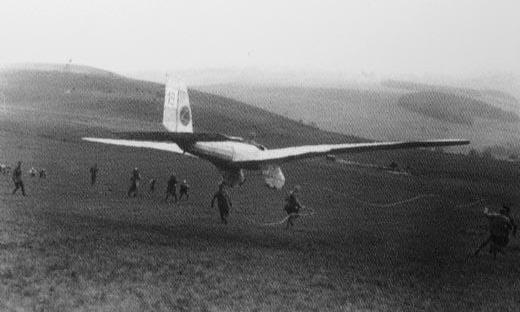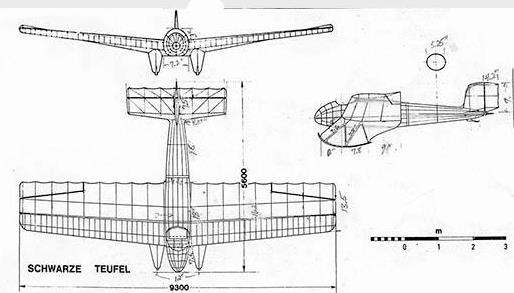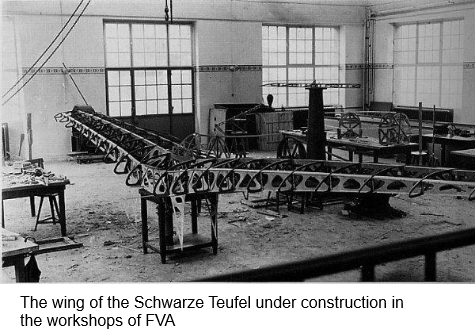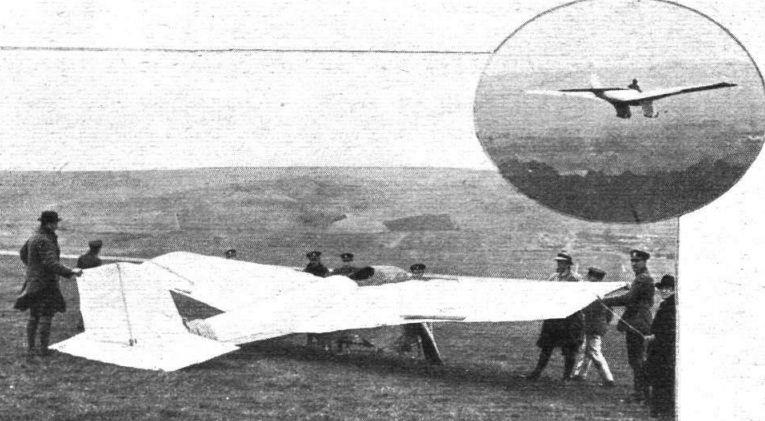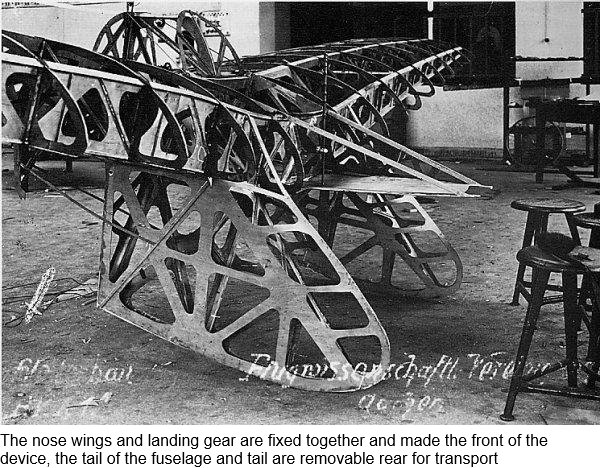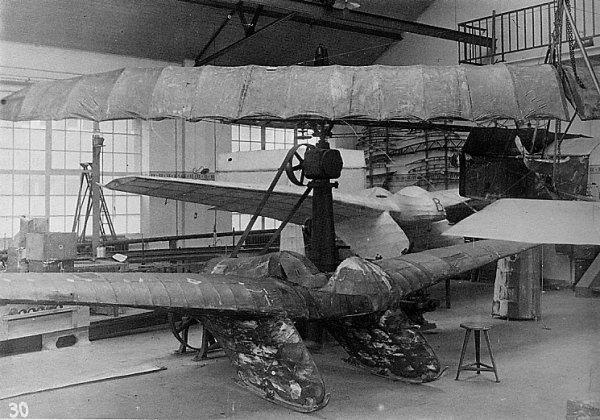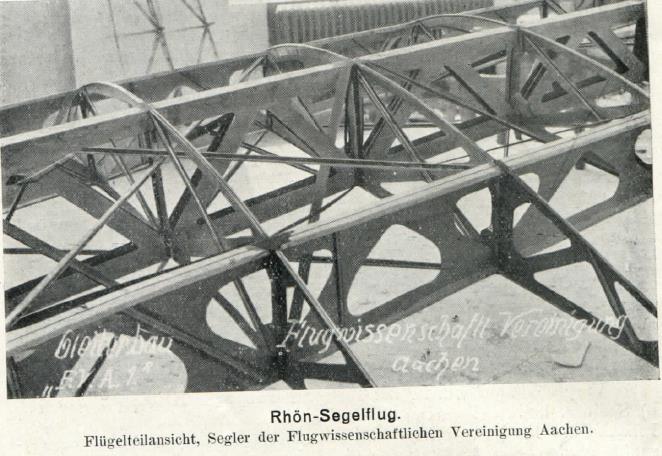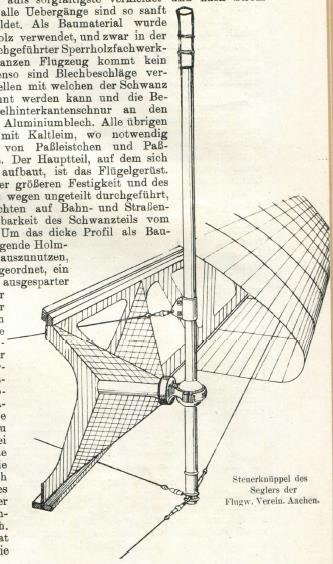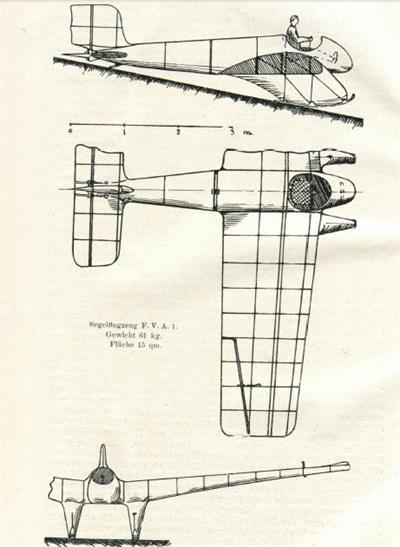| Type | |
| Dimensions | Length 5,0 m, wingspan 9,0 m |
| Weights | |
| Performance |
| Type | Werk.Nr | Registration | History | |
| Built in 1920, took part in the first Rhön | ||||
FVA 1 "Schwarze Teufel"
The glider that draws Klemperer is based on theories developed by Professor Hugo Junkers and previously applied for the first all-metal aircraft. They are mainly based on the use of a cantilever monoplane wing using a very thick profile inside which are placed all the reinforcements necessary to stiffening of the wing to the exclusion of masts, shrouds and other commonly used tensioners at the time. Particular research is also conducted to reduce drag items do not contribute to the lift: their surfaces are minimized and fabric-covered to the highest profile overall.
The glider has a wingspan of 9.5 m, 5.5 m long and weighs 62 kg empty for a wing de 15m2 surface. The structure, built in wood, is made of two removable parts:
- one includes the wing, cockpit, nose fuselage and landing gear;
- the other brings the rear fuselage and empennage. The assembly of the two elements is located at the fuselage frame at the trailing edge of the wing.
The wing has a trapezoidal shape in plan and section a flat lower surface profile of 22% relative thickness, the study was conducted at the Prandl blower Göttingen. It is built around three spars with soles T are joined by a truss rods. Also built in the lattice webs are threaded and glued to the longitudinal beams, the torsional rigidity is ensured by strips of fabric glued diagonally. The leading edge is coated cardboard while the trailing edge is formed of a piano wire together the rib bottoms. The excellent resistance to bending and torsion is obtained by multiplying the braces, brackets and small section of reinforcements; the complexity of realization resulting consideration is the weight gain compared to a conventional building of the same structural strength. Thus, the main spar, tested the coefficient 5, weighs only 7.5 kg; all the ribs: 3,7 kg each wing: 870 g; wing completed weighs 24 kg Surface 15m2.
The cockpit is shaped by a light structure interfaced and the pilot's seat is attached to the main beam. The controls are arranged in a conventional manner and attack the rudders by steel cables. The landing gear has two carefully contoured legs carrying at their ends Ash skates. At the rear of train leg pants, two steel pins allow the attachment of the sling used for takeoff.
The fabric of the glider is achieved by means of a very thin black veil (90 g / m2) waterproof collodion. This painting was obtained through tender reports qu'entretenait a student with the daughter of a spinner of Aachen. The color of the stabilizer and the appearance of saurian antediluvian FVA 1 were the origin of his Christian name: "Schwarze Teufel" = black devil.
With the support of von Karman, construction began in December 1919 in a disused vein wind tunnel aerodynamic laboratory. At that time, was located in Aachen area Belgian occupation and any airplane building was prohibited. The technical school was under the supervision of a Board of Control and the start of construction began clandestinely under the pretext of wind tunnel studies of aerodynamic models. Gradually, as the work progressed and became recognizable elements, the Board of Control was more suspicious and multiplied surprise inspections. Klemperer was increasingly hard to convince the Belgians it was only aerodynamic studies. The end of August 1920 was coming and it was urgent to route to the Black Devil Wasserkuppe where competition tests were conducted on July 15. Fortunately, bad weather that prevailed in Europe in the summer of 1920 had brought Ursinus to extend the trials until September 7.
When all aircraft are banned, the journey of the glider, from Aachen to the Rhön (250 km) through the Belgian occupation zones, English and French, was organized as a commando expedition. The first step was to carry the Devil Black school in a small truck freight yard trying to avoid roadside checks allies. As night falls, the truck left the city by small roads in principle little oversight, but after a few kilometers, the convoy encountered a column of trucks carrying troops. With great composure, students were integrated discreetly military convoy crossed without problems for several dams finally to the cover of darkness, to slip into the station where the glider was loaded on a tray and covered wagon with a tarpaulin. Péter Terkatz, who was assigned to accompany the glider to destination, naively took with her cigarette and cigar boxes cartridges to bribe those who might oppose the driving out of the operation. By learning from the conductor, Terkatz noticed that the load control would be done in Cologne by the English. These were based on the waybills of goods to be presented by the conductor to perform checks. As the conductor was incorruptible, Terkatz was forced to steal the slip on the Black Devil. Luckily, no one noticed the deception and the glider came to Gersfeld (in the unoccupied zone) without incident on Sept. 3 and was sent to the Wasserkuppe to be reassembled.
Cutting to Wasserkuppe
When the team consisting of Aachen Wolfgang Klemperer, Paul Stock, Theodor Bienen, Karl Fromm, Fritz Heffels Péter Terkatz and Kurt Weil arrives at the Wasserkuppe, the record is not very bright. First, the weather is terrible and the few flyable days since July 15; Ursinus extended the contest but no longer believes. The results are distressing: the best flight was directed by Willy Peizner who has managed a slip 452 m in 52 seconds.
The arrival of the team of Aachen and especially their machine completely original causes renewed interest. September 4, Klemperer and the Devil Black are on track and take off with a new device that delights the participants: the bungee. At the time, the throws were mainly in the race (as in hang gliding today) or, where the glider was too heavy with the help of assistants who were loading the glider on their shoulders and ran up the slope 'that the lift necessary for flight is acquired. Given the configuration and the weight of their machine, the team of Aachen had developed a catapult launch system by using elastic cable used to carry the dampers on aircraft landing gear. V Cable place before the glider came to take on two studs attached to the rear of train legs. Two assists firmly maintained the stern while at the end of each strand 4 men began to run to stretch the bungee cord; when the pilot considered sufficient tension, he shouted "los" (kinky!) for aid placed at the stern and the glider was leaving, catapulted into the slope. September 4, therefore, Klemperer directed two short flights of 315 and 362 m are the first Black Devil flights; it appears that the glider is centered slightly back and that management has insufficient efficacy, apart from this, the behavior and handling are excellent. The third flight is carried out on the western slope and lasts 2'22 ", the trajectory is very tense and stable, the glider which operates without doubt the slope effect arises at 1852 m from its starting point the. record of the Wasserkuppe is largely beaten.
The glider that draws Klemperer is based on theories developed by Professor Hugo Junkers and previously applied for the first all-metal aircraft. They are mainly based on the use of a cantilever monoplane wing using a very thick profile inside which are placed all the reinforcements necessary to stiffening of the wing to the exclusion of masts, shrouds and other commonly used tensioners at the time. Particular research is also conducted to reduce drag items do not contribute to the lift: their surfaces are minimized and fabric-covered to the highest profile overall.
The glider has a wingspan of 9.5 m, 5.5 m long and weighs 62 kg empty for a wing de 15m2 surface. The structure, built in wood, is made of two removable parts:
- one includes the wing, cockpit, nose fuselage and landing gear;
- the other brings the rear fuselage and empennage. The assembly of the two elements is located at the fuselage frame at the trailing edge of the wing.
The wing has a trapezoidal shape in plan and section a flat lower surface profile of 22% relative thickness, the study was conducted at the Prandl blower Göttingen. It is built around three spars with soles T are joined by a truss rods. Also built in the lattice webs are threaded and glued to the longitudinal beams, the torsional rigidity is ensured by strips of fabric glued diagonally. The leading edge is coated cardboard while the trailing edge is formed of a piano wire together the rib bottoms. The excellent resistance to bending and torsion is obtained by multiplying the braces, brackets and small section of reinforcements; the complexity of realization resulting consideration is the weight gain compared to a conventional building of the same structural strength. Thus, the main spar, tested the coefficient 5, weighs only 7.5 kg; all the ribs: 3,7 kg each wing: 870 g; wing completed weighs 24 kg Surface 15m2.
The cockpit is shaped by a light structure interfaced and the pilot's seat is attached to the main beam. The controls are arranged in a conventional manner and attack the rudders by steel cables. The landing gear has two carefully contoured legs carrying at their ends Ash skates. At the rear of train leg pants, two steel pins allow the attachment of the sling used for takeoff.
The fabric of the glider is achieved by means of a very thin black veil (90 g / m2) waterproof collodion. This painting was obtained through tender reports qu'entretenait a student with the daughter of a spinner of Aachen. The color of the stabilizer and the appearance of saurian antediluvian FVA 1 were the origin of his Christian name: "Schwarze Teufel" = black devil.
With the support of von Karman, construction began in December 1919 in a disused vein wind tunnel aerodynamic laboratory. At that time, was located in Aachen area Belgian occupation and any airplane building was prohibited. The technical school was under the supervision of a Board of Control and the start of construction began clandestinely under the pretext of wind tunnel studies of aerodynamic models. Gradually, as the work progressed and became recognizable elements, the Board of Control was more suspicious and multiplied surprise inspections. Klemperer was increasingly hard to convince the Belgians it was only aerodynamic studies. The end of August 1920 was coming and it was urgent to route to the Black Devil Wasserkuppe where competition tests were conducted on July 15. Fortunately, bad weather that prevailed in Europe in the summer of 1920 had brought Ursinus to extend the trials until September 7.
When all aircraft are banned, the journey of the glider, from Aachen to the Rhön (250 km) through the Belgian occupation zones, English and French, was organized as a commando expedition. The first step was to carry the Devil Black school in a small truck freight yard trying to avoid roadside checks allies. As night falls, the truck left the city by small roads in principle little oversight, but after a few kilometers, the convoy encountered a column of trucks carrying troops. With great composure, students were integrated discreetly military convoy crossed without problems for several dams finally to the cover of darkness, to slip into the station where the glider was loaded on a tray and covered wagon with a tarpaulin. Péter Terkatz, who was assigned to accompany the glider to destination, naively took with her cigarette and cigar boxes cartridges to bribe those who might oppose the driving out of the operation. By learning from the conductor, Terkatz noticed that the load control would be done in Cologne by the English. These were based on the waybills of goods to be presented by the conductor to perform checks. As the conductor was incorruptible, Terkatz was forced to steal the slip on the Black Devil. Luckily, no one noticed the deception and the glider came to Gersfeld (in the unoccupied zone) without incident on Sept. 3 and was sent to the Wasserkuppe to be reassembled.
Cutting to Wasserkuppe
When the team consisting of Aachen Wolfgang Klemperer, Paul Stock, Theodor Bienen, Karl Fromm, Fritz Heffels Péter Terkatz and Kurt Weil arrives at the Wasserkuppe, the record is not very bright. First, the weather is terrible and the few flyable days since July 15; Ursinus extended the contest but no longer believes. The results are distressing: the best flight was directed by Willy Peizner who has managed a slip 452 m in 52 seconds.
The arrival of the team of Aachen and especially their machine completely original causes renewed interest. September 4, Klemperer and the Devil Black are on track and take off with a new device that delights the participants: the bungee. At the time, the throws were mainly in the race (as in hang gliding today) or, where the glider was too heavy with the help of assistants who were loading the glider on their shoulders and ran up the slope 'that the lift necessary for flight is acquired. Given the configuration and the weight of their machine, the team of Aachen had developed a catapult launch system by using elastic cable used to carry the dampers on aircraft landing gear. V Cable place before the glider came to take on two studs attached to the rear of train legs. Two assists firmly maintained the stern while at the end of each strand 4 men began to run to stretch the bungee cord; when the pilot considered sufficient tension, he shouted "los" (kinky!) for aid placed at the stern and the glider was leaving, catapulted into the slope. September 4, therefore, Klemperer directed two short flights of 315 and 362 m are the first Black Devil flights; it appears that the glider is centered slightly back and that management has insufficient efficacy, apart from this, the behavior and handling are excellent. The third flight is carried out on the western slope and lasts 2'22 ", the trajectory is very tense and stable, the glider which operates without doubt the slope effect arises at 1852 m from its starting point the. record of the Wasserkuppe is largely beaten.
Seglers der Flug Verein. Aachen,
mit welchem beim Rhön-Segelflug die besten Erfolge erzielt wurden, waren im wesentlichen die Ueberlegungen leitend gewesen, daß auch für den motorlosen Flug die möglichste Heraufsetzung des Verhält- nisses von Auftrieb zu Gesamtwiderstand mehr noch als die Beschränkung mit der spezifischen Flächenbelastung von grundlegendem Nutzen ungewöhnliche Dicke von 42 cm. Sämtliche Kippen wiegen zu-sammen 3,74 kg. Sie sind in kunstvoller Weise durch die Aussparungen der Holme hindurchgesteckt, und ihre Stege sind mit besonderen Leistchen mit den Holmstegon verleimt. Den Stirndruck nimmt eine Diagonalstrebenkonstruktion auf, und ein besonderes System raum- diagonal gespannter Bänder verleiht dem Gerüst eine ausgezeichnete Steifigkeit gegen Torsion. Anstelle einer Nasenleiste ist der Teil der Flügel vor dem Vorderholm mit Karton umkleidet. Von vorn gesehen zeigen die Flügel V-Form und zwar sind sie nach Art der Vogel- flügel etwas durchgebogen. Der Grundriß der Fläche ist trapezförmig.
An einem Hilfsholm sind 0,75 qm große Querruder angelenkt, die außen eine leichte Aufbiegung zeigen. Eine Querruderklappe wiegt 870 gr Dabei ist sie ohne Verspannung formstarr. Der ganze fertig bespannte Flügel hat mit ca 15 qm Flächeninhalt ein Gewicht von 24 kg. Zur Bespannung diente ein besonders feiner schwarzer Voile- stoff, der mit einem besonderen, hier erstmalig verwendeten kollodium-haltigen Mittel imprägniert, bei Ii kg cm Reißfestigkeit knapp 90 gr/qm wog. Die Imprägnierung hat sich bei dem nassen Wetter in der Rhön vorzüglich bewährt. Der Führersitz ist zwischen Haupt- und Vorderholm eingebaut und lastet im wesentlichen auf Letzterem. Der Knüppel aus Duraluminrohr von 130 gr Gewicht ist mit einer hohlen Stahlkugel von 46 gr Gewicht in einem aus Aluminiumlegierung herausgearbeiteten Hohlkugelschalenring von 32 gr allseitig beweglich gelagert. Das Gelenk ist an einem pyramidonartigen Sperrholzträger am Vorderholm befestigt. Der Fußhebel für die Seitensteuerbetätigung ist hohl zusammengebaut und wiegt bei großer Festigkeit 150 gr incl. Aluminium blechfußrasten. Die Rumpf spitze, welche so stark gebaut war, daß sie auch beim Kopfstand den Führer zu schützen im Stande war, trägt eine verkleidete Karosserie aus Bambusgorippe. Der aus den Flächen herauswachsende Rumpfvorderteil endigt hinter der Flächenhinterkante in dem Sperrholztrennspant. In etwas eigenartiger Weise sind die Landungsgestellkörper, ohne seitliche Verstützung aus den Holmen der Fläche herauswachsend, ausgebildet. Sie haben sich von vorzüglicher Festigkeit gezeigt und gestatteten auf den allseitig gummigefederten eschenen Kufen ein überaus angenehmes Landen. Ihre völlige stromlinienförmige Verkleidung sichert ihnen den denkbar geringsten Luftwiderstand. Ein ungünstiger Einfluß derselben auf die Richtungsstabilität hat sich nicht gezeigt. Der Schwanz wird von einem aus zusammengebundenen Rohrstöcken gebildeten niedrigen Sporn gestützt. Das durchgehende Höhenruder von 1400 gr Gewichtund das 600 gr schwere Seitenruder sind auf Duraluminbolzen inDuraluminbüchsen gelagert und leichtdemontierbar. Die Steuerseilekönnen an eigenartigen, sehr sicheren Karabinerhaken getrennt undmit sicherheitsnadelart igen stählernen Zapfen an den Steuerschwingengelöst werden, ohne daß die mitStahldraht ausgeführte Spannschloß-sicherung gelöst zu werden braucht. Die Demontage oder Montage des ganzen Schwanzes der übrigens komplett nur 11 kg wiegt, kann in 2 Minuten von drei Männern bewirkt werden. Zum Straßen- transport konnte der Hauptteil des Apparates querschiffs auf einem eigens dazu gebauten zweirädrigen Wagen gefahren werden. Der Start erfolgte durch Anziehen an einer Gummischnur, die um Haken an den hinteren Kufenenden geschlungen wurde und die die Hilfsmannschaft nach dem Start in den Händen behielt. Die Maschinestartete trotzdem sie mit 62 kg Leergewicht ca 81 ,-9 kg Flächen-belastung mit Führer besitzt bereits glatt bei 4 m sec. Wind, andererseits hielt sie sich auch in den starken Böen der letzten Rhönflugtagesehr stabil. Die vorzügliche Sicht, die richtige Lage des Schwer-punktes, die gute Steuerempfindlichkeit und Wendigkeit sowie dieguten Eigenschaften des dicken Profils beim schnellen und beimlangsamen Fluge machen sie zu einem Typ von überaus angenehmen Flugeigenschaften, und zu Segel versuchen durch Ausnutzung vonßöenenergie ebenso geeignet wie zum Schulen.Die Maschine wurde nach einem ursprünglichen Entwurf vonDipl.-Ing. Klemperer von den Mitgliedern der FlugwissenschaftlichenVereinigung Aachen, Herren der Aachener Studentenschaft und einigenPraktikern erbaut. Herr Professor von Karman hatte die Arbeiten inder weitherzigsten Weise durch zur Verfügungstellung von Räumlich-keiten, Werkstatt etc. des aerodynamischen Instituts der TechnischenHochschule für die Montage unterstützt und gefördert.
mit welchem beim Rhön-Segelflug die besten Erfolge erzielt wurden, waren im wesentlichen die Ueberlegungen leitend gewesen, daß auch für den motorlosen Flug die möglichste Heraufsetzung des Verhält- nisses von Auftrieb zu Gesamtwiderstand mehr noch als die Beschränkung mit der spezifischen Flächenbelastung von grundlegendem Nutzen ungewöhnliche Dicke von 42 cm. Sämtliche Kippen wiegen zu-sammen 3,74 kg. Sie sind in kunstvoller Weise durch die Aussparungen der Holme hindurchgesteckt, und ihre Stege sind mit besonderen Leistchen mit den Holmstegon verleimt. Den Stirndruck nimmt eine Diagonalstrebenkonstruktion auf, und ein besonderes System raum- diagonal gespannter Bänder verleiht dem Gerüst eine ausgezeichnete Steifigkeit gegen Torsion. Anstelle einer Nasenleiste ist der Teil der Flügel vor dem Vorderholm mit Karton umkleidet. Von vorn gesehen zeigen die Flügel V-Form und zwar sind sie nach Art der Vogel- flügel etwas durchgebogen. Der Grundriß der Fläche ist trapezförmig.
An einem Hilfsholm sind 0,75 qm große Querruder angelenkt, die außen eine leichte Aufbiegung zeigen. Eine Querruderklappe wiegt 870 gr Dabei ist sie ohne Verspannung formstarr. Der ganze fertig bespannte Flügel hat mit ca 15 qm Flächeninhalt ein Gewicht von 24 kg. Zur Bespannung diente ein besonders feiner schwarzer Voile- stoff, der mit einem besonderen, hier erstmalig verwendeten kollodium-haltigen Mittel imprägniert, bei Ii kg cm Reißfestigkeit knapp 90 gr/qm wog. Die Imprägnierung hat sich bei dem nassen Wetter in der Rhön vorzüglich bewährt. Der Führersitz ist zwischen Haupt- und Vorderholm eingebaut und lastet im wesentlichen auf Letzterem. Der Knüppel aus Duraluminrohr von 130 gr Gewicht ist mit einer hohlen Stahlkugel von 46 gr Gewicht in einem aus Aluminiumlegierung herausgearbeiteten Hohlkugelschalenring von 32 gr allseitig beweglich gelagert. Das Gelenk ist an einem pyramidonartigen Sperrholzträger am Vorderholm befestigt. Der Fußhebel für die Seitensteuerbetätigung ist hohl zusammengebaut und wiegt bei großer Festigkeit 150 gr incl. Aluminium blechfußrasten. Die Rumpf spitze, welche so stark gebaut war, daß sie auch beim Kopfstand den Führer zu schützen im Stande war, trägt eine verkleidete Karosserie aus Bambusgorippe. Der aus den Flächen herauswachsende Rumpfvorderteil endigt hinter der Flächenhinterkante in dem Sperrholztrennspant. In etwas eigenartiger Weise sind die Landungsgestellkörper, ohne seitliche Verstützung aus den Holmen der Fläche herauswachsend, ausgebildet. Sie haben sich von vorzüglicher Festigkeit gezeigt und gestatteten auf den allseitig gummigefederten eschenen Kufen ein überaus angenehmes Landen. Ihre völlige stromlinienförmige Verkleidung sichert ihnen den denkbar geringsten Luftwiderstand. Ein ungünstiger Einfluß derselben auf die Richtungsstabilität hat sich nicht gezeigt. Der Schwanz wird von einem aus zusammengebundenen Rohrstöcken gebildeten niedrigen Sporn gestützt. Das durchgehende Höhenruder von 1400 gr Gewichtund das 600 gr schwere Seitenruder sind auf Duraluminbolzen inDuraluminbüchsen gelagert und leichtdemontierbar. Die Steuerseilekönnen an eigenartigen, sehr sicheren Karabinerhaken getrennt undmit sicherheitsnadelart igen stählernen Zapfen an den Steuerschwingengelöst werden, ohne daß die mitStahldraht ausgeführte Spannschloß-sicherung gelöst zu werden braucht. Die Demontage oder Montage des ganzen Schwanzes der übrigens komplett nur 11 kg wiegt, kann in 2 Minuten von drei Männern bewirkt werden. Zum Straßen- transport konnte der Hauptteil des Apparates querschiffs auf einem eigens dazu gebauten zweirädrigen Wagen gefahren werden. Der Start erfolgte durch Anziehen an einer Gummischnur, die um Haken an den hinteren Kufenenden geschlungen wurde und die die Hilfsmannschaft nach dem Start in den Händen behielt. Die Maschinestartete trotzdem sie mit 62 kg Leergewicht ca 81 ,-9 kg Flächen-belastung mit Führer besitzt bereits glatt bei 4 m sec. Wind, andererseits hielt sie sich auch in den starken Böen der letzten Rhönflugtagesehr stabil. Die vorzügliche Sicht, die richtige Lage des Schwer-punktes, die gute Steuerempfindlichkeit und Wendigkeit sowie dieguten Eigenschaften des dicken Profils beim schnellen und beimlangsamen Fluge machen sie zu einem Typ von überaus angenehmen Flugeigenschaften, und zu Segel versuchen durch Ausnutzung vonßöenenergie ebenso geeignet wie zum Schulen.Die Maschine wurde nach einem ursprünglichen Entwurf vonDipl.-Ing. Klemperer von den Mitgliedern der FlugwissenschaftlichenVereinigung Aachen, Herren der Aachener Studentenschaft und einigenPraktikern erbaut. Herr Professor von Karman hatte die Arbeiten inder weitherzigsten Weise durch zur Verfügungstellung von Räumlich-keiten, Werkstatt etc. des aerodynamischen Instituts der TechnischenHochschule für die Montage unterstützt und gefördert.
